|
The scrapping of Montour #70 13-Jun-2007
|
| |
|
 The cab headlight from Montour 70 has undergone some changes in its 50+ years,
but I can thankfully state, it is now preserved. The glass number boards are intact
and that funky floodlight has been removed. It needs a complete sandblasting or
sanding and repainted. The cab headlight from Montour 70 has undergone some changes in its 50+ years,
but I can thankfully state, it is now preserved. The glass number boards are intact
and that funky floodlight has been removed. It needs a complete sandblasting or
sanding and repainted.
Gene P. Schaeffer |
|
 With the top of the cab now removed, one of the 70's trucks has also been partially
dis-assembled. Behind the truck is the top of the cab roof.
With the top of the cab now removed, one of the 70's trucks has also been partially
dis-assembled. Behind the truck is the top of the cab roof.
Gene P. Schaeffer |
|
 With great sadness, Montour 70 ceased to exist today.
With great sadness, Montour 70 ceased to exist today.
I spent most of the morning at Glassport and a couple afternoon hours with the 70 as the torches reduced this locomotive to pieces. Sometime Tuesday, the delivery of liquid oxygen arrived and the torches were fired again. Two cuts were made in the locomotive frame, one on each side of the fuel tank that put the locomotive in 3 sections for lifting. The front of the locomotive was lifted away first. The frame with attached fuel tank was lifted second and moved off to the side. The crew cab was cut into 2 sections, with the cut made just above the window frames. The top of the cab was removed allowing the last real lift of the frame and bottom half of the cab to go last.
After the cab roof was lifted, the guys took a break. I asked them, do you mind of I remove the headlight casing for preservation? Both guys quickly told me to go-ahead and take it...and anything else you want. I borrowed their crescent wrench and began working on the 4 headlight bolts. Inside another minute, both guys were standing there with me offering help. One guy said he would get his sockets while the other said, let me torch it off. I was hesitant of the torch and doing damage to the casing, but was assured he would be careful. Another minute later, the headlight casing was off and loaded into the back of their RAM 3500 pick up. These guys ran it down to my car and unloaded it for me. What a wonderful bunch of guys...Inside the headlight case you can clearly see the glass number boards still with "70" on them.
After the cab/frame section was lifted from off the truck, and after the hornets realized their home was gone forever, I climbed up into the open cab and made numerous photos of the cab interior. I was finally able to remove the reverse lever, but I set it on the roof of the cab and forgot it. I was able to remove the control box complete with Electro-Motive tags for the fuel pump, engine start, etc. Once again, I removed the 4 bolts with the cresent wrench, but the torch quickly cut the conduit and home it also came. The 2 brass LIFT COVER-PULL RING plates were also removed from the locomotive frame and preserved.
Montour 70 had one last headlight meet before its demise, as CSX 6000 came by, long hood forward with about 25 cars.
Shortly before leaving for the day, a low boy 18 wheeler arrived and the front section of the frame was lifted onto the low boy. The crane operator told the truck driver that section alone weighed 53,000 pounds according to the scale built into his crane.
Another sad day for us Montour RR Historians. Gene P. Schaeffer |
|

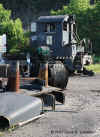 With deep sadness, and a Special Thanks to our
CSX friend Jeff for the "heads up", I visited Montour 70 at Glassport. Indeed, just as Jeff
reported, Montour 70 is being scrapped. I made a number of photos of the remains of the 70. With deep sadness, and a Special Thanks to our
CSX friend Jeff for the "heads up", I visited Montour 70 at Glassport. Indeed, just as Jeff
reported, Montour 70 is being scrapped. I made a number of photos of the remains of the 70.
It was always preached to me that some things happen for reasons. I learned during my visit
in talking with the 2 guys doing the salvage, they Officially started cutting up Montour 70
on Friday June 8, 2007. On Saturday June 9, 2007 they again returned to Glassport to work on
cutting up the 70, but about mid-day their tanks ran empty and their torches went out.
They are still waiting for re-fills so they can proceed on salvaging the 70. If it wasn't for the
empty tanks, there probably would be little to photograph during my visit. In just one and
one-half days of salvage, they had removed the long hood, removed the diesel engine, generator,
air compressor, cut the underneath out on the rear couple, removed 3 of 4 steps and had worked
on some of the brake rigging.
The cab headlight was still intact and for a time I had contemplated asking if I could remove it.
These 2 guys warmed up to me quickly so if Tim or any others feel lucky, get over to Glassport
A.S.A.P and ask. I was also lucky when I asked if I could climb up inside the cab for some last photos,
I was told "just don't get hurt"...
I photographed as much of the cab as possible. I then walked out on the long hood-frame and
photographed much of the space now vacant of diesel engine, generator and air compressor.
The cab is still intact with many of the I.D. plates still screwed to the headlight and control
box's. I tried without success to remove the reverse lever, but it didn't want to come out. The feed
valve, throttle stand, gauges, hand brake were all photographed as well as the double heading
cut out. Many fond memories from the days when I ran the SW-9's...
Thanks to All...
Gene P. Schaeffer |
|
 Moments before removing the top of the cab of Montour 70, the torch finalizes cutting
through the steel so the crane can make a clean lift. Gene P. Schaeffer
Moments before removing the top of the cab of Montour 70, the torch finalizes cutting
through the steel so the crane can make a clean lift. Gene P. Schaeffer |
|
 Executing its last meet, Montour 70 stands by as CSX 6000 passes enroute East on CSX's former P&LE trackage here in
Glassport. Gene P. Schaeffer
Executing its last meet, Montour 70 stands by as CSX 6000 passes enroute East on CSX's former P&LE trackage here in
Glassport. Gene P. Schaeffer |
|
 One of two locations on Montour 70's frame,6175-1 is stamped. Gene P.
Schaeffer
One of two locations on Montour 70's frame,6175-1 is stamped. Gene P.
Schaeffer |
|

The transition lever for Montour 70. This transition lever was a manual operation
ever. This view, appears to have the lever in the Parallel position. After the cab roof
was removed and the bee's left, I was able
to determine why I could NOT remove the reverse lever, the throttle was still in #8 and
this transition lever was still in parallel. As soon as I returned the throttle to
idle, and moved the transition lever back to series, the reverser came right out...but alas...
I left it sitting on top of the cab roof...Gene P. Schaeffer |
|
 The throttle stand for Montour 70. on the right is the throttle itself, with positions stop and #1-#8.
On the left is the transition lever. Bottom center, where DIRECTION is located is the location for
The throttle stand for Montour 70. on the right is the throttle itself, with positions stop and #1-#8.
On the left is the transition lever. Bottom center, where DIRECTION is located is the location for
the forward/reverse lever, which is now removed. The small lever on the left is for the bell.
Gene P. Schaeffer |
|
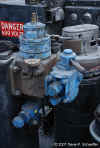 The air brake stand for Montour 70, on the top and missing its handle is the automatic which
The air brake stand for Montour 70, on the top and missing its handle is the automatic which
is the train brakes. Next and below the automatic is the Independent brake
which is only for the engine(s). The twist knob on the bottom left is the feed valve.
Missing is the sander valve which is the small triangle seat almost dead center. The sander and bell valves
were identical in size and opposite each other separated by the automatic brake valve.
DANGER 600 Volts is the electrical cab and the throttle stand is on the right.
In the background you can see the engine warning bell. Gene P.
Schaeffer |
|
 This photo shows the Isolation switch for the SW-7's. The SW-9's had 'em in the same
location and for the same purpose. When the engineer wanted to isolate a unit in a consist,
a simple turn to "start" would allow the locomotive to continue to idle, but would remove the locomotive
from loading...
This photo shows the Isolation switch for the SW-7's. The SW-9's had 'em in the same
location and for the same purpose. When the engineer wanted to isolate a unit in a consist,
a simple turn to "start" would allow the locomotive to continue to idle, but would remove the locomotive
from loading...
This switch was directly behind the engineer up against the big picture window.
Gene P. Schaeffer
For those of you not familiar with this type of loco , this is the "isolation box"
I referred to a few posts back, that I would sit on behind the engineer. Tim
Sposato |
|
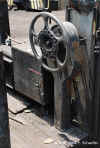 The hand brake stand for Montour 70. This hand brake stand was inside the locomotive cab almost directly
behind the engineer. Gene P. Schaeffer
The hand brake stand for Montour 70. This hand brake stand was inside the locomotive cab almost directly
behind the engineer. Gene P. Schaeffer |
|
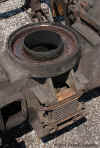 Montour 70 had one of its trucks painted blue. I don't believe this truck was a original truck
Montour 70 had one of its trucks painted blue. I don't believe this truck was a original truck
since it had a raised welded number about center. Its other truck could of been a original.
This image shows where the center sill of the locomotive truck, where the locomotive frame
rested. The round hollow center is for air that is pumped through to cool the traction
motors. There is a hole in the center of the locomotive frame which matches to this round
hole, and I'm not sure where the traction motor blowers are located. The traction motors are
designed to interlock with the truck support that is seen below the center sill. The square hole near
the left lower corner is the duct for the blowers for the traction motors.
Gene P. Schaeffer |
|
 Here is what the 70's headlight used to look like, the interior components have not been made by
EMD for a many years. Most parts have to be salvaged from derelicts or even handmade.
Here is what the 70's headlight used to look like, the interior components have not been made by
EMD for a many years. Most parts have to be salvaged from derelicts or even handmade.
Sometimes they can be found through collectors, or lying around old shops, like the one of this type
that was lying on the top of a cabinet at MRR Jct. I packed it out the back door while a shop employee
covered for me.
The number boards were missing, but I like to think it may have been off the #72. It's nice to know that
maybe three of these still exist from the three SW-7's. Tim Sposato |
|
 Hot Engine and Low Oil alarms for Montour 70. I don't think the fan is standard.
Gene P. Schaeffer.
Hot Engine and Low Oil alarms for Montour 70. I don't think the fan is standard.
Gene P. Schaeffer. |
|
 I have no clue what this is other than there are 2 fuel oil filters here. Yes, there is smoke coming out of the pipe.
It was burning for quite some time. Gene P. Schaeffer
I have no clue what this is other than there are 2 fuel oil filters here. Yes, there is smoke coming out of the pipe.
It was burning for quite some time. Gene P. Schaeffer |
|
 This is the Westinghouse traction motor plate...funny it reads Glassport...same place the 70 met its fate.
Gene P. Schaeffer
This is the Westinghouse traction motor plate...funny it reads Glassport...same place the 70 met its fate.
Gene P. Schaeffer |
|
 Cooling fan for Montour 70. The red locomotive sitting next to Montour 70,
also a SW-7 had 2 cooling fans. Looking at the side of the locomotive cab, the red locomotive
was Union 561. Gene P. Schaeffer
Cooling fan for Montour 70. The red locomotive sitting next to Montour 70,
also a SW-7 had 2 cooling fans. Looking at the side of the locomotive cab, the red locomotive
was Union 561. Gene P. Schaeffer |
|
 EMD Generator tag. Gene P. Schaeffer
EMD Generator tag. Gene P. Schaeffer |
|
 A total of 107 photos were recorded today of the final stages of dis-mantling Montour 70.
A total of 107 photos were recorded today of the final stages of dis-mantling Montour 70.
My last photo of the day, weighing in at just over 53,000 pounds according to the scale
built into the crane, the front frame section of the 70 is loaded onto a low boy 18 wheeler.
Montour 70 is making its final road trip. May She Rest in Peace, Gene
P. Schaeffer |
|
 One of Montour 70's truck, after being lifted to release both wheel/traction motor sets, is
moved away from the 70 and placed in the pile of growing pieces of the cut up locomotive.
Gene P. Schaeffer
One of Montour 70's truck, after being lifted to release both wheel/traction motor sets, is
moved away from the 70 and placed in the pile of growing pieces of the cut up locomotive.
Gene P. Schaeffer |
|
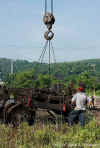 The lead truck of Montour 70 is being lifted so both axles/traction motors assemblies will
drop out of the truck. Gene P. Schaeffer
The lead truck of Montour 70 is being lifted so both axles/traction motors assemblies will
drop out of the truck. Gene P. Schaeffer |
|
 Cables are positioned to lift the front truck of Montour 70 so the wheels sets/traction motor assemblies will drop
out. Gene P. Schaeffer
Cables are positioned to lift the front truck of Montour 70 so the wheels sets/traction motor assemblies will drop
out. Gene P. Schaeffer |
|
 The frame of Montour 70 was cut in 2 locations, on each side of the fuel tank. Seen here the front section of the frame has been removed as the middle section of the frame had dropped to the ground as the cab section has tilted backwards. A Sad sight.
Gene P. Schaeffer
The frame of Montour 70 was cut in 2 locations, on each side of the fuel tank. Seen here the front section of the frame has been removed as the middle section of the frame had dropped to the ground as the cab section has tilted backwards. A Sad sight.
Gene P. Schaeffer |
|
 A wheel set with journal box assembly. Gene P. Schaeffer
A wheel set with journal box assembly. Gene P. Schaeffer |
|
 Just ahead of the cab, the frame is cut through. Gene P. Schaeffer
Just ahead of the cab, the frame is cut through. Gene P. Schaeffer |
|
 Missing its journal box, the end of a locomotive axle. This locomotive axle housed a friction bearing journal.
Gene P. Schaeffer
Missing its journal box, the end of a locomotive axle. This locomotive axle housed a friction bearing journal.
Gene P. Schaeffer |
|
 The red hook is fastened underneath the frame walkway prior to lifting. The frame for Montour 70 is about 3 inches thick in places. This photo was taken just below the door way leading out of the locomotive cab-
Fireman's side. Gene P. Schaeffer
The red hook is fastened underneath the frame walkway prior to lifting. The frame for Montour 70 is about 3 inches thick in places. This photo was taken just below the door way leading out of the locomotive cab-
Fireman's side. Gene P. Schaeffer |
|
 After the roof of the locomotive cab was removed, direct sunlight enabled documentation of the inside of Montour 70's cab. This view shows what could be considered the "dashboard" in the locomotive cab. The top white colored switch is the heater fan. On both sides of that switch are the air
gauges for the brakes, then directly underneath the heater fan control switch was the light for indicating Wheel Slip which appears to have been modified in this view.
Gene P. Schaeffer
After the roof of the locomotive cab was removed, direct sunlight enabled documentation of the inside of Montour 70's cab. This view shows what could be considered the "dashboard" in the locomotive cab. The top white colored switch is the heater fan. On both sides of that switch are the air
gauges for the brakes, then directly underneath the heater fan control switch was the light for indicating Wheel Slip which appears to have been modified in this view.
Gene P. Schaeffer |
|
 Another view of the cut frame, engineers side. Almost direct center is the pad in which the diesel engine rested on. There were 4 locations that I could identify for the diesel engine.
Gene P. Schaeffer
Another view of the cut frame, engineers side. Almost direct center is the pad in which the diesel engine rested on. There were 4 locations that I could identify for the diesel engine.
Gene P. Schaeffer |
|
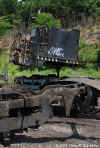 Again I must state how fortunate I was being able to be up close and personal with the demise of Montour 70. The 2 fellows doing the salvage were wonderful and offered their assistance in removing anything I wanted. The one fellow spoke broken English and continuously called me "sir"... I was able to climb up in the cab, walk in the void engine room, use their tools as long as I was careful. Saying thank you never seems enough.
Again I must state how fortunate I was being able to be up close and personal with the demise of Montour 70. The 2 fellows doing the salvage were wonderful and offered their assistance in removing anything I wanted. The one fellow spoke broken English and continuously called me "sir"... I was able to climb up in the cab, walk in the void engine room, use their tools as long as I was careful. Saying thank you never seems enough.
In this view, the lower half of the locomotive cab is lifted off the last intact truck. In the foreground was the lead truck from Montour 70 with the outline of the top of the cab roof behind.
Gene P. Schaeffer |
|
 Montour 70 is passed by a CSX empty hopper train on the former P&LE Mon Line. Is this our friend Jeff?
Gene P. Schaeffer
Montour 70 is passed by a CSX empty hopper train on the former P&LE Mon Line. Is this our friend Jeff?
Gene P. Schaeffer |
|
 From inside the cab of Montour 70, looking out over a void locomotive frame.
Gene P. Schaeffer
From inside the cab of Montour 70, looking out over a void locomotive frame.
Gene P. Schaeffer |
|
 This Saturday June 23 morn, yet another visit to Glassport to do a final
tribute to Montour 70. Since it has been nearly 2 weeks since the 70 had
been cut up, I felt sure the hulk of the 70 was now just a photographed
memory, but I needed to know for sure she was gone.
This Saturday June 23 morn, yet another visit to Glassport to do a final
tribute to Montour 70. Since it has been nearly 2 weeks since the 70 had
been cut up, I felt sure the hulk of the 70 was now just a photographed
memory, but I needed to know for sure she was gone.
After parking the car, I could see where the 70 had been torched, and I
could see where the 3 frame sections, the cab roof, trucks and traction
motor-wheel assemblies were placed after torching, and they were no
longer here.
As I neared that fateful spot, a hope and a prayer something from the
70 had been left behind haunting my spirits of the demise of Montour 70.
There in the weeds, next to a pile of new ties, was the outline of the cab
door from the 70. Amazingly, the cab door was forgotten and left behind.
The door handle, inside locking mechanism and bottom glass pane were not
sent to scrap. I flipped the cab door over onto its back and recorded its
image on black & white. Gene P. Schaeffer |
|
 In addition to finding the cab door to Montour 70 at Glassport, there on
the opposite side of the pile of railroad ties was the section of flooring
that is removable, which on the SW-9's allowed a trainman to crawl under
the cab floor where wood blocks were kept for re-railing. Yet another
artifact of Montour 70 simply discarded. Gene P. Schaeffer
In addition to finding the cab door to Montour 70 at Glassport, there on
the opposite side of the pile of railroad ties was the section of flooring
that is removable, which on the SW-9's allowed a trainman to crawl under
the cab floor where wood blocks were kept for re-railing. Yet another
artifact of Montour 70 simply discarded. Gene P. Schaeffer |
|
 The third and probably last significant remain left behind at Glassport
belonging to Montour 70 were the outside sleeves for the exhaust stacks,
obviously torched off for loading and eventual transportation by truck to
the scrap yard. Gene P. Schaeffer
The third and probably last significant remain left behind at Glassport
belonging to Montour 70 were the outside sleeves for the exhaust stacks,
obviously torched off for loading and eventual transportation by truck to
the scrap yard. Gene P. Schaeffer |
|
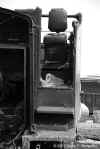 As I had expected, the remains of Montour 70 were taken to Tube City at
Mifflin Junction where the hulk of this SW-7 would further be reduced by
cutting torch. In this view, the roof less locomotive cab was laid to rest
adjacent to the yard tracks in Mifflin Yard. After making a number of
exposures of the remains of Montour 70 at this her final resting place, I
stepped back and looked Eastward into Mifflin Yard. All of the remaining
interchange tracks between the Union and W&LE were empty. Tube City
had cars on their tracks, but standing there looking up into the yard, I
wondered how many times Montour 70 "ran extra" into Mifflin
Junction with interchange coal for the Union RR, passing probably right
overtop of where she now rests for her last days. How bizarre in this
view, the Fireman's "seat box" still pretty much intact, sits
vacant and lifeless, not so much as it was the last time Montour 70 made
her way through the Yard at Mifflin Junction....probably 50 some years
ago...Gene P. Schaeffer
As I had expected, the remains of Montour 70 were taken to Tube City at
Mifflin Junction where the hulk of this SW-7 would further be reduced by
cutting torch. In this view, the roof less locomotive cab was laid to rest
adjacent to the yard tracks in Mifflin Yard. After making a number of
exposures of the remains of Montour 70 at this her final resting place, I
stepped back and looked Eastward into Mifflin Yard. All of the remaining
interchange tracks between the Union and W&LE were empty. Tube City
had cars on their tracks, but standing there looking up into the yard, I
wondered how many times Montour 70 "ran extra" into Mifflin
Junction with interchange coal for the Union RR, passing probably right
overtop of where she now rests for her last days. How bizarre in this
view, the Fireman's "seat box" still pretty much intact, sits
vacant and lifeless, not so much as it was the last time Montour 70 made
her way through the Yard at Mifflin Junction....probably 50 some years
ago...Gene P. Schaeffer |
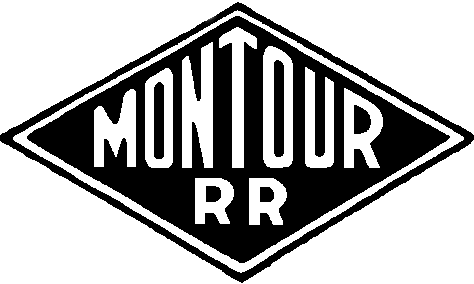 Montour
Railroad
Montour
Railroad 